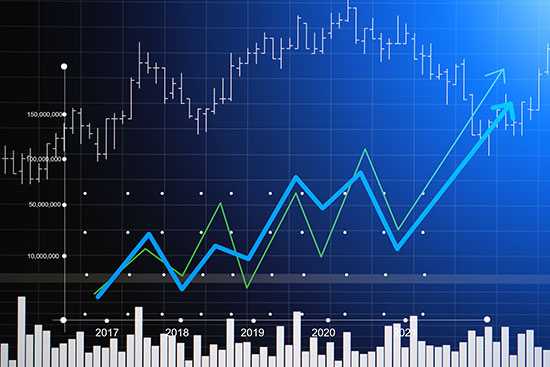忘了去年12月吧,历史告诉我们美股涨势将延续到圣诞节后

|
2019年的美国股市极其火爆。截至10月25日,标普500指数上涨逾23%。2018年年底美股曾经下跌近20%,后在圣诞前夜触底,进而推动了今年的行情。 去年的美国股市也曾经表现强劲,但在年底前功尽弃,这让许多投资者担心今年又要出现上演类似的戏码。实际上,《巴伦》周刊最新的大资金调查显示,只有27%的基金经理看好美股未来12个月的走势,这是20多年来看涨人数最少的一次。几乎三分之一的受访职业经理人都自视为看空派。 历史让我们看到,股市往往会遵循牛顿的理论,一直保持原有的运动方向。今年1至9月,标普500指数上涨近21%。这样的行情实际上比大家所认为的还要正常。从1926年算起,标普指数在前三个季度走出两位数涨幅的情况一共出现了42次(包括今年)。也就是说,在这些自然年中,投资者在第四季度前获得两位数回报的年份几乎占了一半。 那么这样的行情延续到年底的有多少次呢? 这个数字实际上高的让人惊讶。此前标普500指数截至9月30日的涨幅达到两位数的年份有41个,而第四季度该指数继续上涨的有35次,而且其中29次都上扬了3%或更高。在这35个年头中,标普指数在第四季度平均上涨了3%左右。1926年以来,该指数前三季度涨幅达到或超过20%的有23年,而这23年中美股在第四季度告跌的只有3次。 但这里要说明一下。历史上股市的惯性效应一直很强,但反转也会很剧烈。在前三个季度实现两位数收益的年份中,美股在第四季度下跌的有6次,而这6次中市场跌幅达到两位数的有3次。 去年,前期大涨的标普500指数在第四季度下跌近14%,是超级反转中的一次。另外两个以动量崩盘收场的年份分别是1929年和1987年。1929年1至9月美股涨幅几乎达到27%,但在当年最后三个月,随着大萧条开始横扫一切,美股也出现了28%的跌幅。 1987年标普500指数如同炮弹出膛,到9月底时上涨了36%。但在10月,美股出现了历史最大的单日跌幅。当年年底该指数几乎下跌了23%,其中很大一部分跌幅出现在那个黑色星期一。 因此,就今年到目前为止的美妙行情来说,既有好消息,也有坏消息。好消息是前三季度大幅上涨后,绝大多数时候美股都在剩下的时间里再次出现高于平均水平的增长。应该把上涨作为基准预期,因为它占的比例为85%。但市场数据还掺杂了异常值,所以坏消息就是大涨之后市场也可能因为动量崩盘而大跌。 这实际上就是股市自身走势的缩影。大多数情况下它都在上涨,而且往往会大幅攀升。但有时它也会下跌,并且是急剧滑落。历史上的那些暴跌都在大涨之后的很短一段时间内出现。 这种《化身博士》般的表现是股市长期预测回报率高于其他金融资产的原因之一。如果不是给大跌创造机会,股市也就不会有这些大涨行情。(财富中文网) 本文作者是注册金融分析师本·卡尔森(Ben Carlson),他是里萨兹财富管理公司(Ritholtz Wealth Management)机构资产管理部门的主任。 译者:Charlie 审校:夏林 |
The stock market is enjoying a rollicking 2019. Through the week ending October 25th, the S&P 500 was up more than 23%. These gains are aided by the fact that stocks fell nearly 20% at the end of 2018 and bottomed out on Christmas Eve of last year. Last year saw a fierce rally trip all over itself to end the year which makes many investors nervous that we're setting up for another leg down this year in a similar fashion. In fact, according to the most recent Barron's Big Money Poll, only 27% of money managers are bullish on the market's prospects over the next 12 months, the lowest reading in more than 20 years. Almost one-third of professional managers surveyed for this poll consider themselves bearish. History shows us stock markets tend to follow Sir Issac Newton's theory that an object in motion stays in motion in the same direction. The S&P 500 was up nearly 21% through the first nine months of this year. These types of gains are actually more normal than you might think. If we go back to 1926, the S&P has been up double-digits through the first three-quarters of the year on 42 occasions (including this year). So almost half of all calendar years have given investors double-digit returns going into the final quarter of a year. So how many of those gains continued into year-end? A surprisingly high number actually. Of the previous 41 years in which the S&P 500 was up double-digits through September 30, there were gains in the 4th quarter on 35 occasions. And 29 of those gains were 3% or higher. The average quarterly gain for the entirety of this time frame was roughly 3%. In 23 years since 1926, the S&P was up 20% or more through the first three quarters of the year. The market was down in the 4th quarter in just 3 out of those 23 years. There is a catch here though. The momentum effect has been strong in the stock market historically but the reversals can be brutal. Three out of the six down quarters following a double-digit return heading into the final three months of the year saw stocks fall by double-digits in the ensuing quarter. One of these massive reversals was last year when the S&P 500 fell nearly 14% in the 4th quarter following big gains to start the year. The other two momentum crashes to end the year came in 1929 and 1987. Stocks were up almost 27% in the first nine months of the year in 1929 but fell close to 28% in the final three months of the year as the mighty Great Depression was underway. In 1987, the S&P 500 shot out of a cannon, up 36% on the year by the end of September. Then stocks experienced the biggest one-day crash in history in the next month. The bulk of the losses occurred on Black Monday in 1987 but stocks ended the 4th quarter of that year down almost 23%. So there's good news and bad news based on the wonderful gains investors have experienced thus far in 2019. The good news is most of the time when stocks are up big three-quarters of the way through the year, they continue to see above-average gains for the remainder of the year. Gains should be the baseline assumption because they've occurred 85% of the time in this situation. But market data is littered with outliers so the bad news is big gains can also be followed by big losses during momentum crashes. This is actually a microcosm of the behavior of the stock market itself. Most of the time stocks go up And when they go up they tend to go up a lot. But sometimes stocks go down and do so in a violent fashion. Those violent crashes historically have come following large gains in a short period of time. This Dr. Jekyll and Mr. Hyde act by the stock market is one of the reasons it has higher expected returns over the long haul than other financial assets. Those big gains wouldn't be present if it wasn't for the possibility of big losses. Ben Carlson, CFA is the Director of Institutional Asset Management at Ritholtz Wealth Management. |













